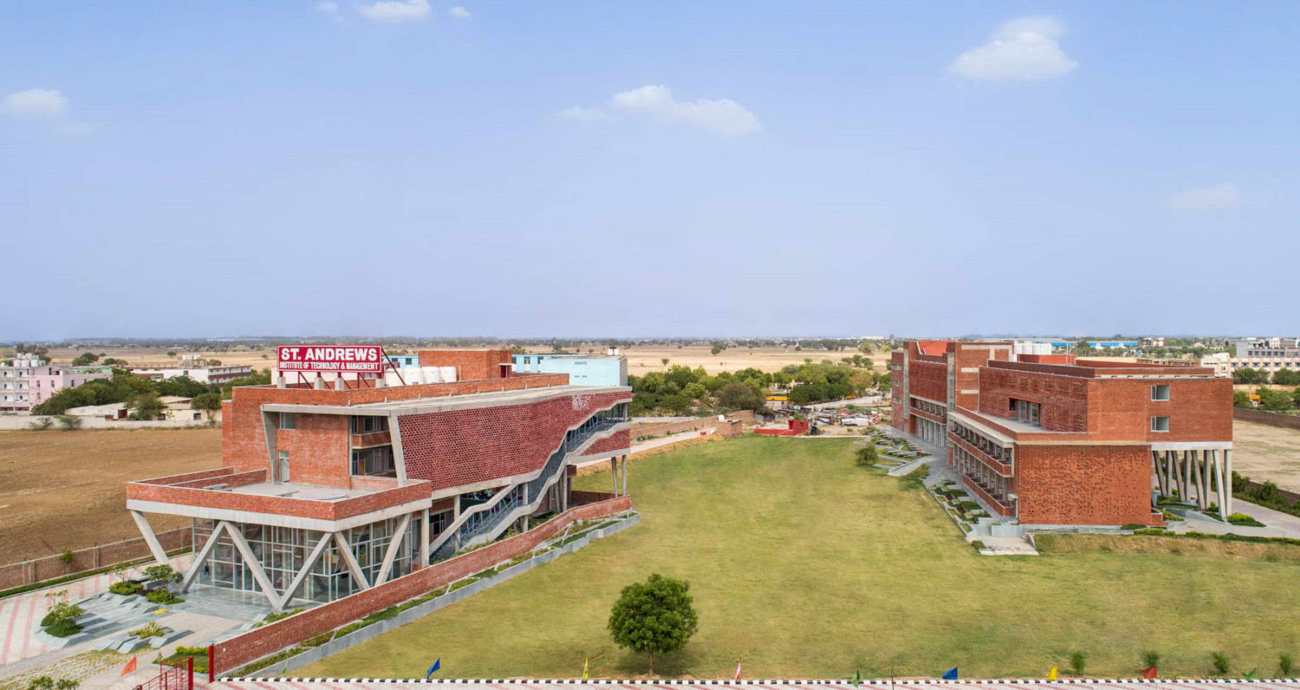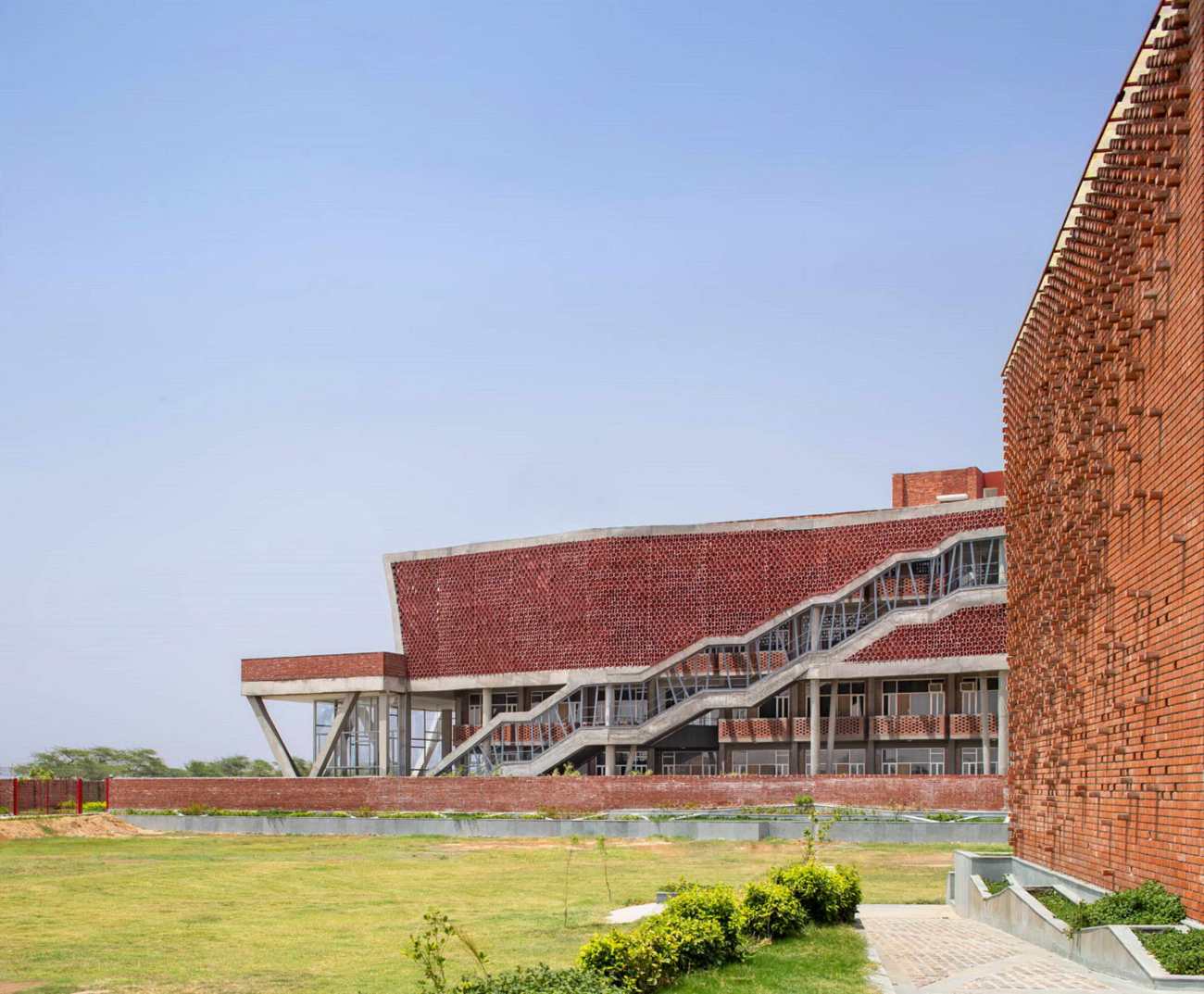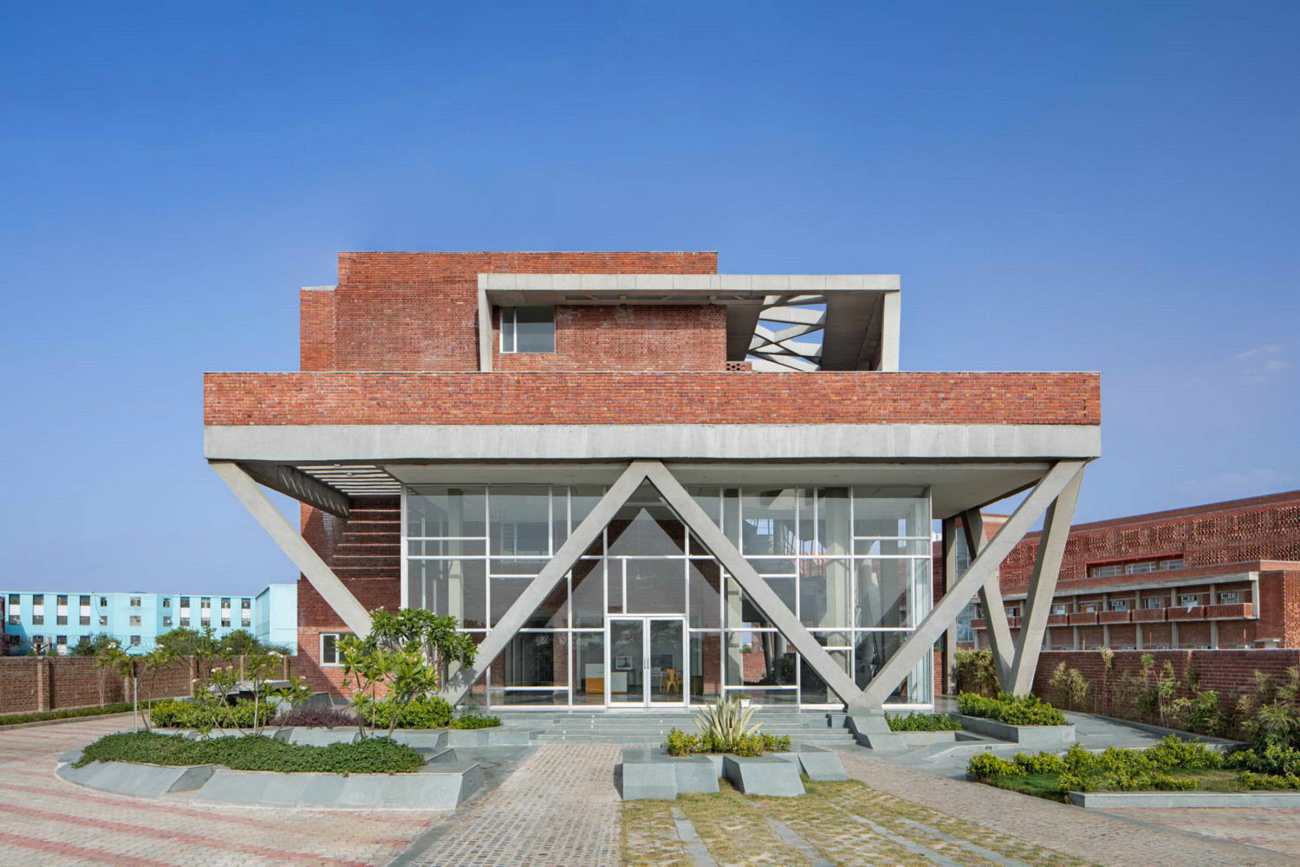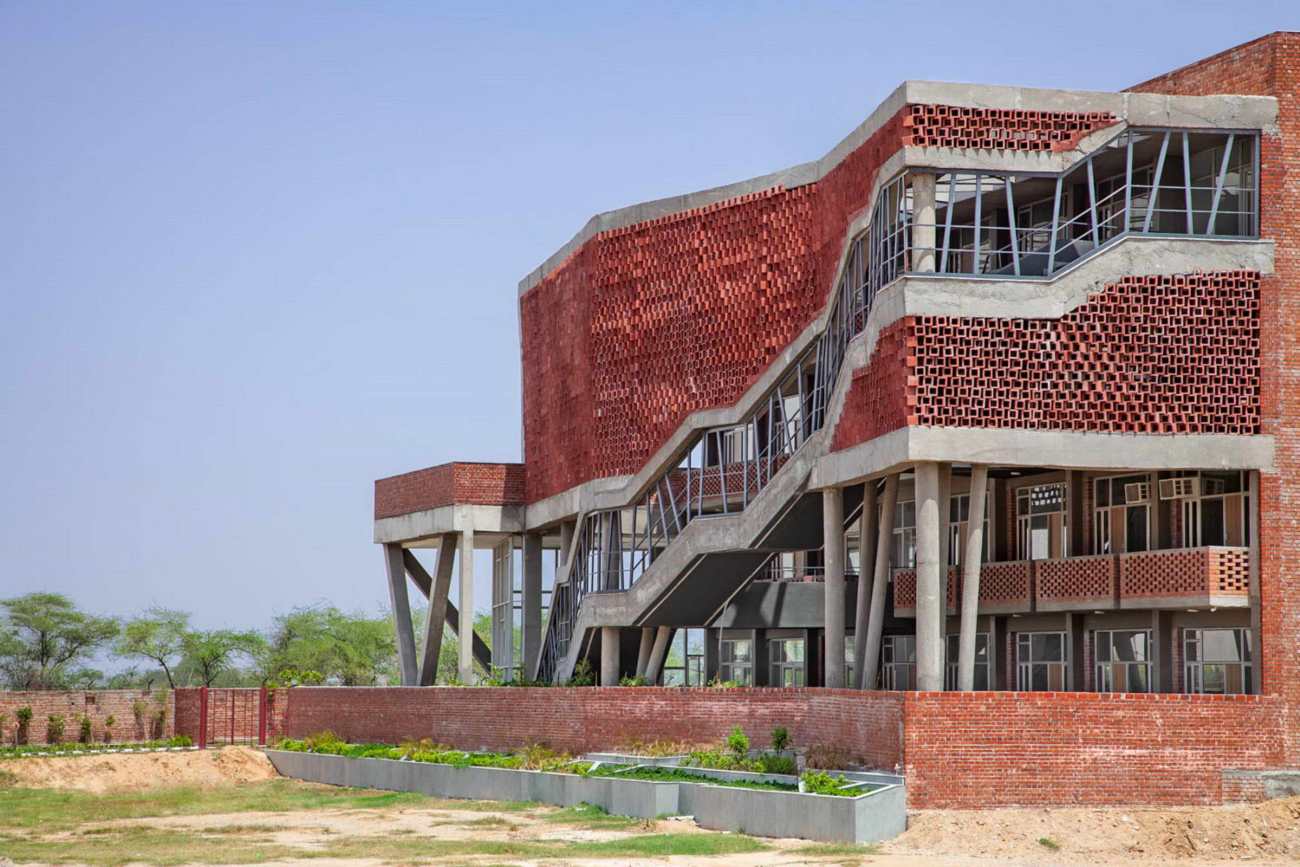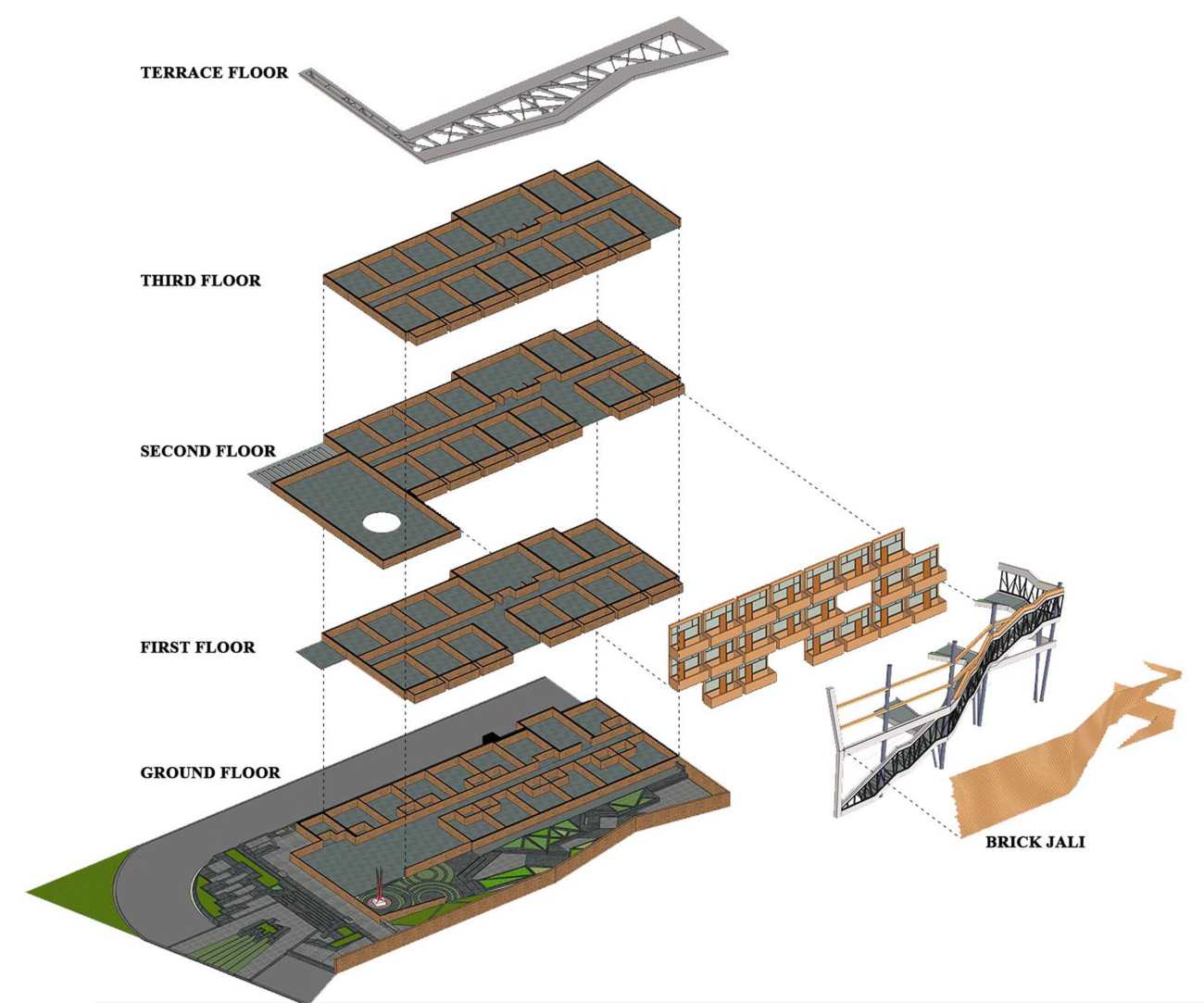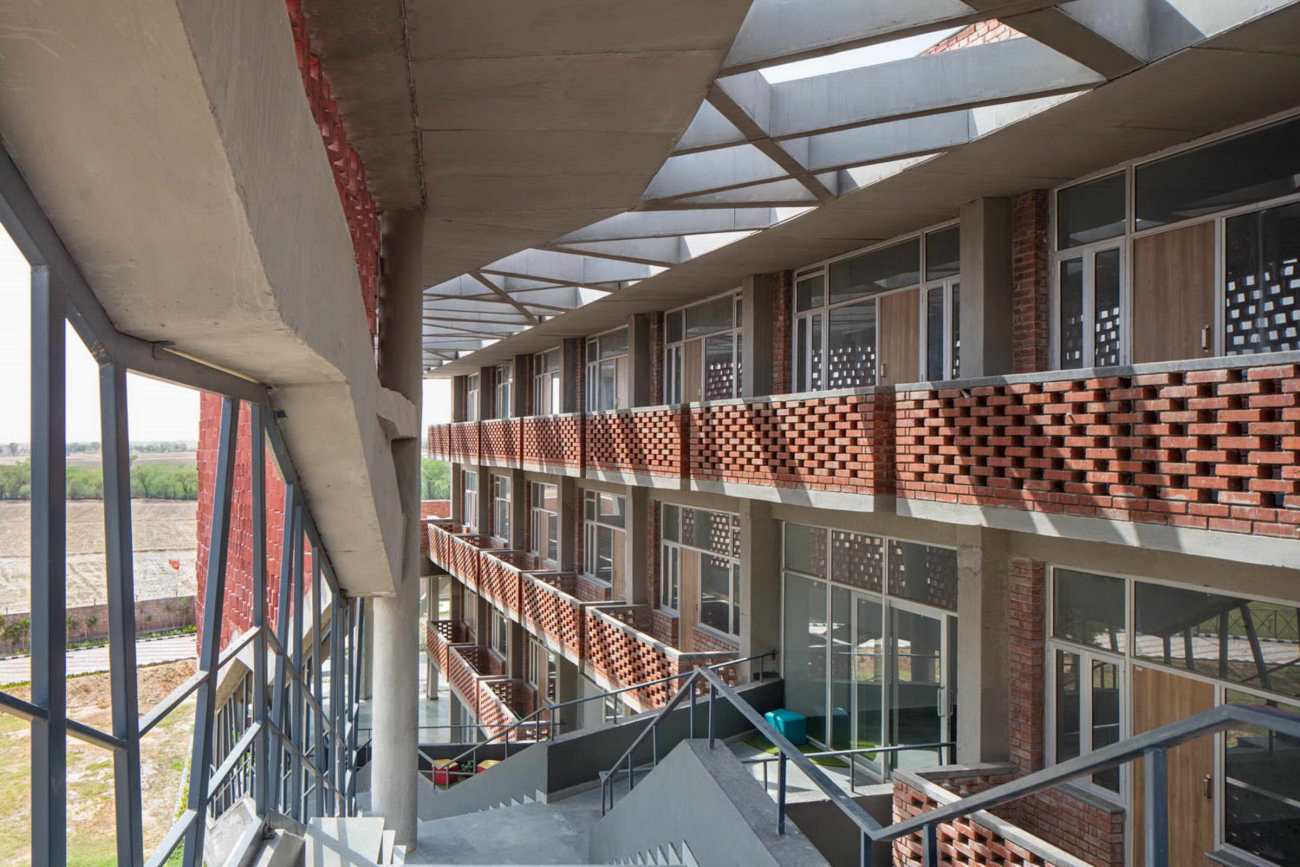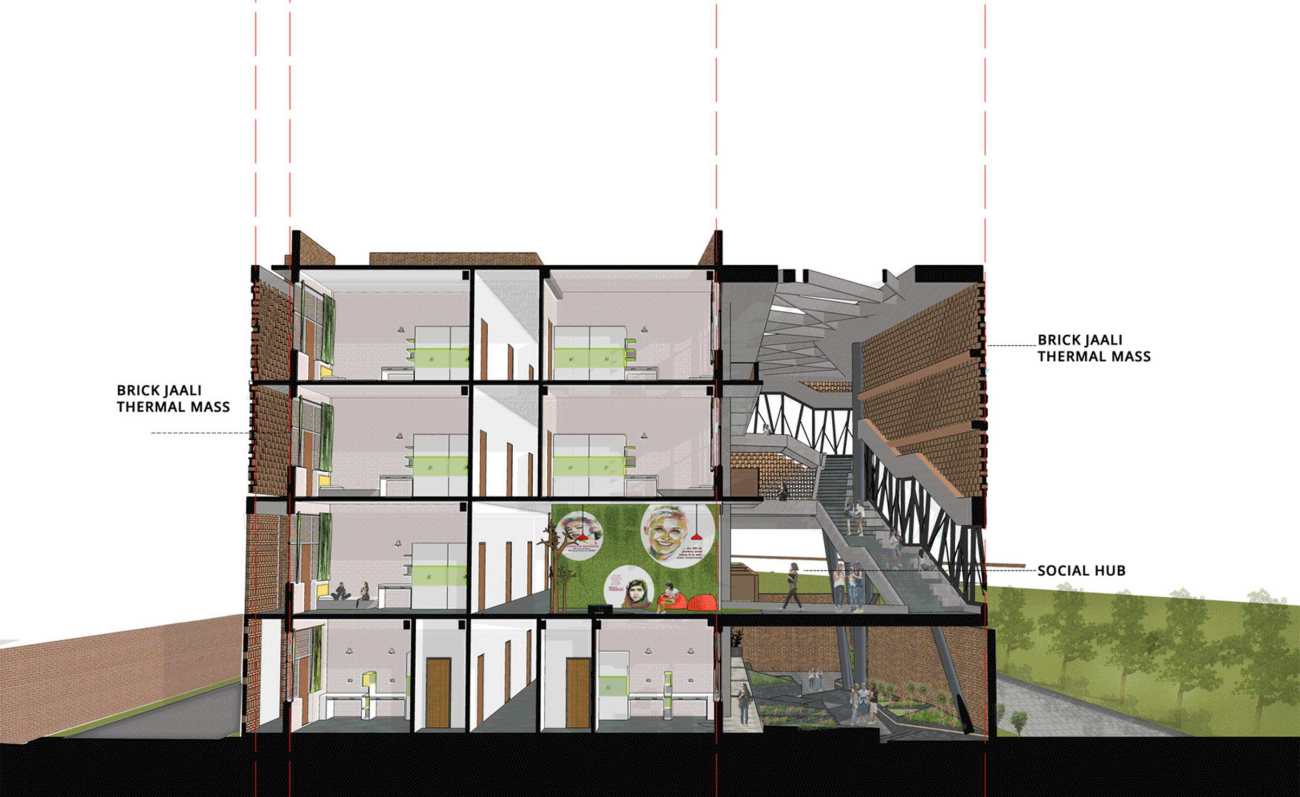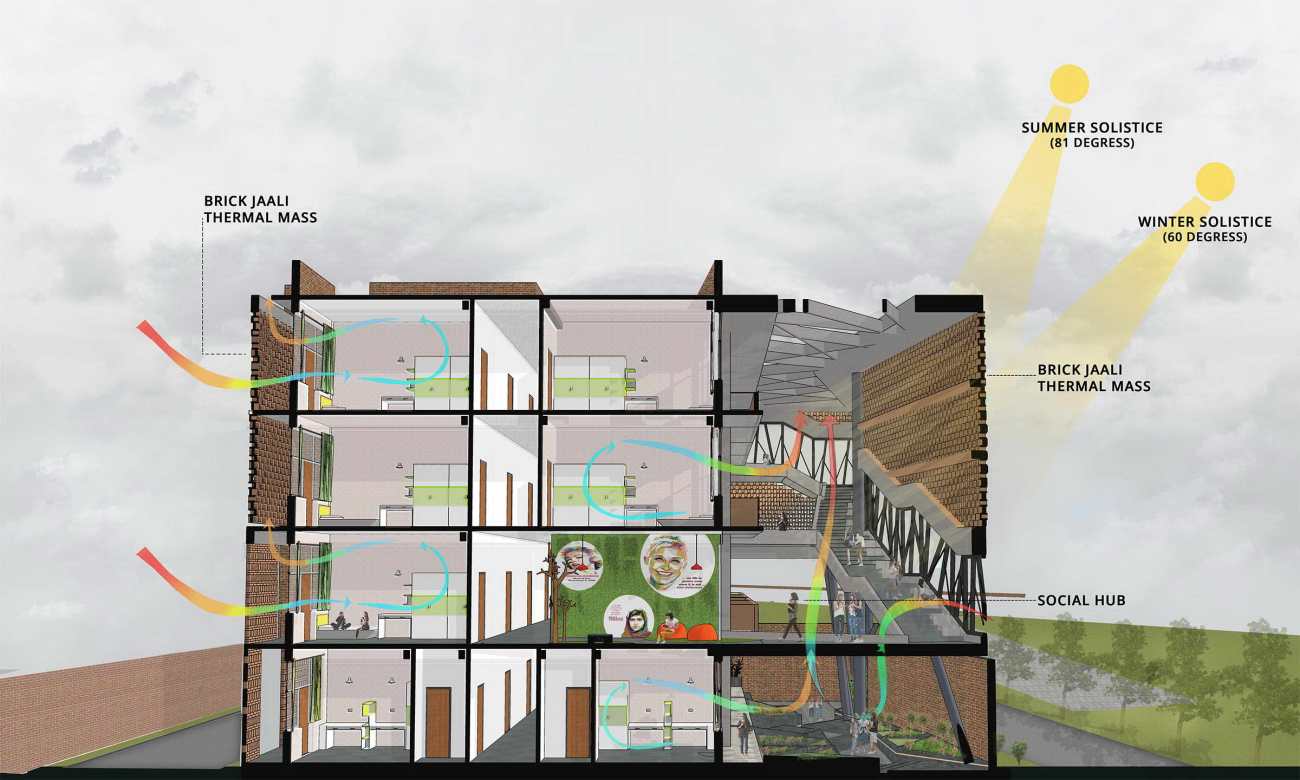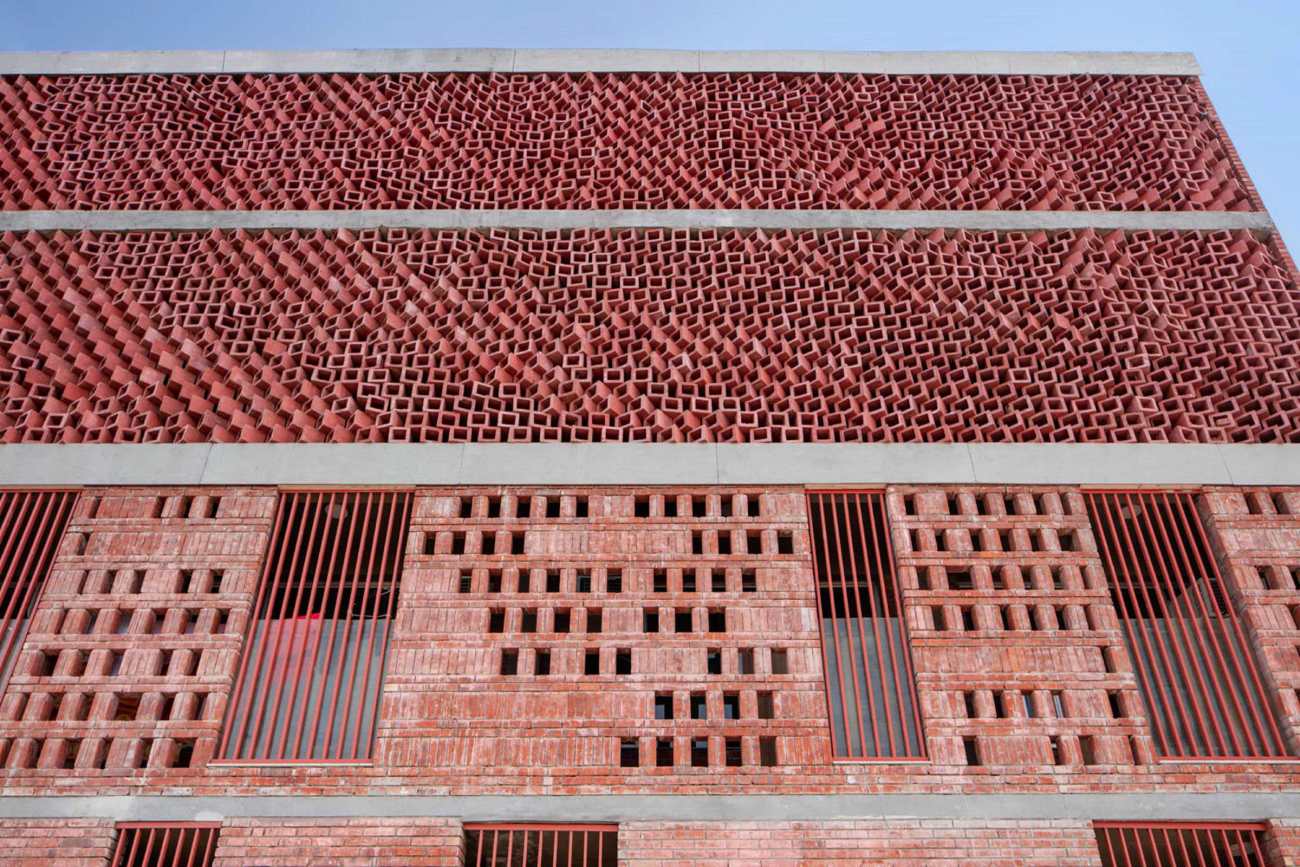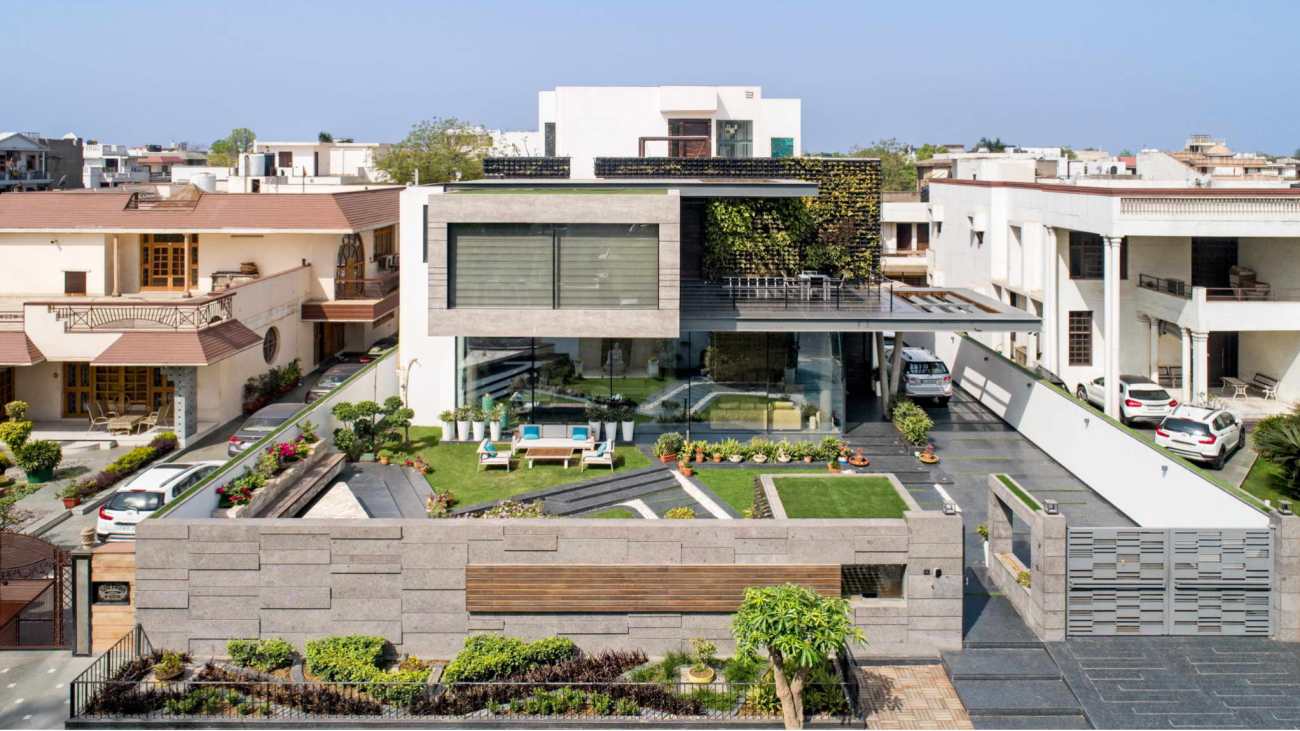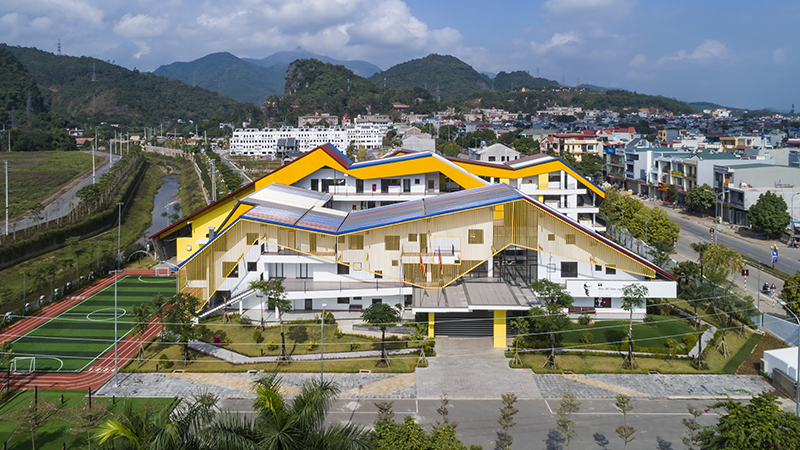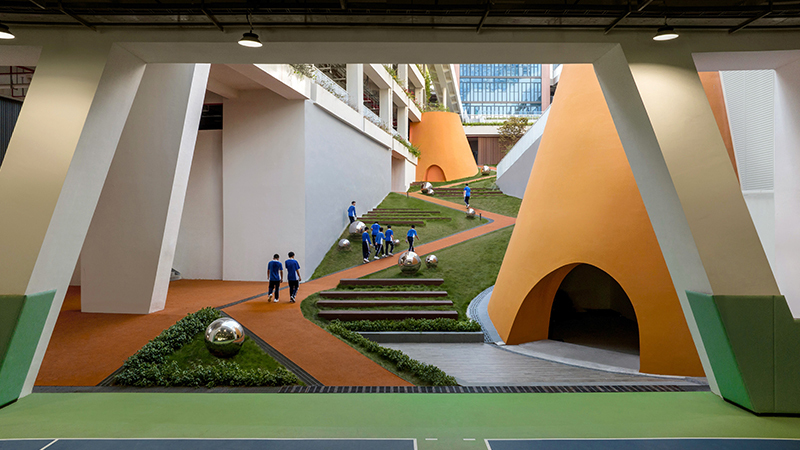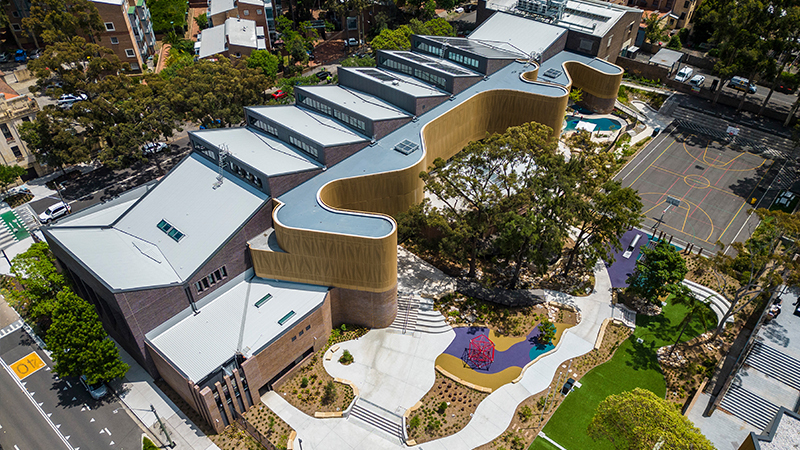| 公司: | Zero Energy Design Lab | 类型: | 建筑 |
|---|---|---|---|
| 地区: | 印度 | 标签: | 学校 |
位于古鲁格拉姆的圣安德鲁斯技术与管理学院的女生宿舍楼通过乡土的视角探索了教育和可持续发展的交叉点。该项目于2020年竣工,占地25,000平方英尺。女生宿舍的设计借鉴了相邻的男生宿舍楼,采用了砖和清水混凝土的结构,所有的结构部件都暴露在外。宿舍的设计使学生在一个优先考虑热舒适和功能的环境中自由活动,成为零能耗设计的典范。
The Girls’ Hostel Block at the St. Andrews Institute of Technology and Management in Gurugram explores the intersection of education and sustainability through the lens of the vernacular. Completed in 2020, the design for the 25,000 sq.ft. Girls’ Hostel takes cues from the adjacent Boys’ Hostel Block and is articulated in brick and fair-faced concrete, with exposed structural members abutting the structure along all sides. The hostel's design empowers students with freedom of movement within an environment that prioritizes thermal comfort and functionality to become an exemplar of zero energy design.
宿舍约有130名学生,寝室分布在四层,此外还设有辅助空间,如茶水间、娱乐区和社交空间。地面层包括12个双人间,以及一个双层的接待处、茶水间和室内活动休息室,学生可以在这里组织聚会和社交活动。
The hostel is home to approximately 130 students, with dorm rooms spread across four levels in addition to hosting ancillary spaces like a pantry, recreational areas as well as social spaces. The ground floor comprises twelve double-occupancy rooms along with a double-height reception, pantry and indoor activity lounge where students can organize gatherings and social events.
客户要求和挑战
该设计从构思到执行都面临着一系列的挑战。主要的设计挑战是为女孩们创造一个安全的中心,一个适合城市总体规划的园中园,不限制运动,同时建立与室外的联系。
Client Brief and Challenges
The design faced a series of challenges from conception to execution. The primary design challenge was to create a secure hub for the girls — a campus within a campus fitting into the urban master plan that did not restrict the movement, while establishing a connection with the outdoors.
为了应对这些限制,布局设计结合了室内和室外空间,在不同层面上进行物理和视觉上的连接,以加强互动和社会活动。此外,为了引入外部景观的感觉,入口门厅和大厅被设计成面向西方的室外空间,并与茶水间相连,这样学生就可以在室外享受他们的夜晚,并向绿色景观延伸。学生们被赋予了在安全环境中创造自己的空间的自由,没有任何强加的限制。
In response to the constraints, the layout has been designed to incorporate indoor and outdoor spaces that connect physically and visually at different levels to enhance interactions and social activities. Moreover, to bring in a sense of the exterior landscape, the entrance foyer and lobby are designed as outdoor spaces to face the west and are connected to the pantry so that students can enjoy their evenings outside with a spill-out into the green landscape. The students have been given the freedom to create their own space in a safe environment, without any imposed restrictions.
在施工方面,楼梯和附属的外墙也是一个设计挑战。独立的外墙要在离建筑30英尺远的地方建造,横跨三层楼的高度,同时要考虑到结构的完整性和抗震性。通过大量的脚手架和浇注过程,使之成为现实。
In terms of construction too, the staircase and the attached façade posed a design challenge. The free-standing façade was to be constructed at a thirty feet distance from the building, spanning a height of three floors keeping in mind structural integrity and earthquake resistance. This was brought to life through an extensive scaffolding and casting process.
设计和规划
该设计试图通过引入适应性舒适的理念来重新解释人类舒适的传统标准--人们的体验不同,并在一定程度上适应各种室内条件,这取决于他们的衣服、他们的活动和一般的身体状况。该建筑作为一系列多维空间展开,通过适应性分层的方法按层次顺序排列。每个空间都被概念化为一个亲密的环境,优先考虑功能和人体舒适度。
Design and Planning
The design seeks to reinterpret conventional standards of human comfort through introducing the idea of adaptive comfort — the principle that people experience differently and adapt, up to a certain extent, to a variety of indoor conditions, depending on their clothing, their activity and general physical condition. The building unfolds as a series of multidimensional spaces, arranged in a hierarchical order through the method of adaptive layering. Each space is conceptualized as an intimate environment that prioritizes both functionality and human comfort.
▼项目轴侧分解 Explode drawing
当学生从建筑的内部进入开放空间时,他们会在不同的热环境中经历不同的过渡。位于底层的活动休息室被放置在景观球场旁边。休息室为学习或交谈创造了一个亲密的环境。此外,相邻的内部景观庭院以密集的植被为特色,通过蒸发冷却来减少热量摄入。从建筑的核心走向室外,下一个过渡是沿建筑西侧立面的二楼露台,它在夏季的早晨和晚间吸引了学生,在冬季则是一个全天的聚集空间。
As students move from the interiors of the building into the open, they experience distinct transitions in varying thermal environments. The activity lounge on the ground flooris placed next to the landscaped court. The lounge creates an intimate environment for studying or conversation. Further, the adjacent internal landscaped court features dense plantation to reduce heat gain through evaporative cooling. From the core of the building towards the outdoor, the next transition is the second-floor terrace along the building’s west façade that attracts students in the mornings and late evenings in summers and serves as an all-day space to congregate during winters.
建筑物的设计保持简单,同时将楼梯等基本元素确定为社会互动的枢纽。随后位于建筑中心的过渡区是一个楼梯,以美学的方式融入南面的外墙,连接所有的楼层。过渡和流通空间,如桥梁,通向休息室和暂停点,为社交和小组学习创造空间。由于桥梁创造了一种视觉连接,它们增强了互动和相互联系。它们无缝地延伸到多个楼层的学生休息室,创造了流动空间。楼梯表现为基本的社会核心,是所有活动的主场,从大规模的庆祝和活动到快速的非正式谈话。外部的大厅区域在晚上经常作为羽毛球场,而院子里则经常举办卡拉姆游戏,这些空间鼓励运动和其他类似的游戏。
The design of the building is kept simple while identifying essential elements like the staircases as hubs for social interaction. The subsequent transitional zone at the heart of the building is a staircase, aesthetically incorporated into the south facade, connecting all the floors. Transitional and circulation spaces such as bridges open into lounges and pause points to create room for socializing and group study. Since the bridges create a visual connection, they enhance interaction and interconnection. They seamlessly extend into the student lounges on multiple floors creating fluid spaces. The staircase manifests as the fundamental social nucleus that is home to all activities, from large scale celebrations and events to quick informal conversations. The exterior lobby area often serves as a badminton court in the evenings and the courtyard that hosts the frequent carrom games are spaces that encourage sports and other similar games.
▼项目剖面图 Section
双层外墙
由于宿舍北侧立面的空间有限,我们开发了一个双层立面,目的是创造一个半透光层,通过控制气流来帮助遮阳和调节外部和内部环境的温度。
The Double Skin Façade
With limited space available along the northern façade of the hostel, a double-skin façade has been developed with the intention of creating a semi-permeable layer that would help in shading and regulating the temperature between the exterior and interior environments via a controlled airflow.
▼双层外墙下的被动式温度调节 Passive temperature regulation under double facades
这个参数化的屏幕借鉴了之前开发的外墙,该外墙横跨学院内邻近的男生宿舍。男生宿舍楼的外墙被设计成一个信封,其中砖的旋转角度被计算出来,以阻止扩散和直接辐射。然而,显而易见的是,砖的深度在旋转时无法形成一个深的围墙,无法以所需的方式阻断漫射辐射。因此,在女生宿舍,外墙屏风使用了空心着色混凝土块,以类似于红砖的颜色。这些砌块成功地解决了三个问题。它们不仅提供了足够的热质量来吸收热量,而且由于深度为8英寸,直接辐射必须穿透砖块内的几层,并在进入室内之前在不同的表面上多次反射,以减少眩光。此外,由于木块是可穿透的,通过这个质量的空气量在伯努利原理的基础上通过压缩而失去热量。根据对太阳辐射热的绝缘分析,这些块体也被稍微旋转了一个特定的角度。
The parametric screen takes cues from the previously developed façade that spanned the adjacent boys’ hostel within the institute. The Boys’ Hostel Block’s façade was designed as an envelope in which the rotational angles of the brick were calculated in order to block diffused and direct radiation. However, it became evident that the depth of the brick when rotated, was not able to create a deep enclosure to cut off diffused radiation in the required manner. Hence, for the girls’ hostel, the exterior façade screen uses hollow pigmented concrete blocks to resemble the colour of the red brick. The blocks have been successful in addressing three concerns. Not only do they provide adequate thermal mass to absorb the heat, but with a depth of eight inches, the direct radiation has to penetrate through several layers within the block and gets reflected on different surfaces multiple times before entering the interiors reducing glare. In addition, since the block is penetrable, the air volume passing through this mass loses its heat through compression on the basis of Bernoulli’s principle. The blocks are also slightly rotated at a specific angle based on the insulation analysis with respect to solar heat gain.
▼参数化的外墙设计 Parameterized bricks
内部的第二层外墙提供了一个空间,用户可以走出阳台或庭院等遮蔽环境。这是一个通过建筑的适应性行为优先考虑热舒适性的空间,并实现了功能性。第二层外墙承担着室内和室外之间的休息空间的作用,如一个露台。它使学生能够掌控他们的环境和活动,并在建筑内与自然相联系。
The interior second skin provides a volume where the user can step out to a shaded environment such as a balcony or court. It is a space that prioritizes thermal comfort through the adaptive behaviour of the building and enables functionality. The second skin takes on the role of a breakout space such as a terrace, between the interior and exterior. It empowers students to take charge of their environment and activity as well as connect with nature while still being inside the building.
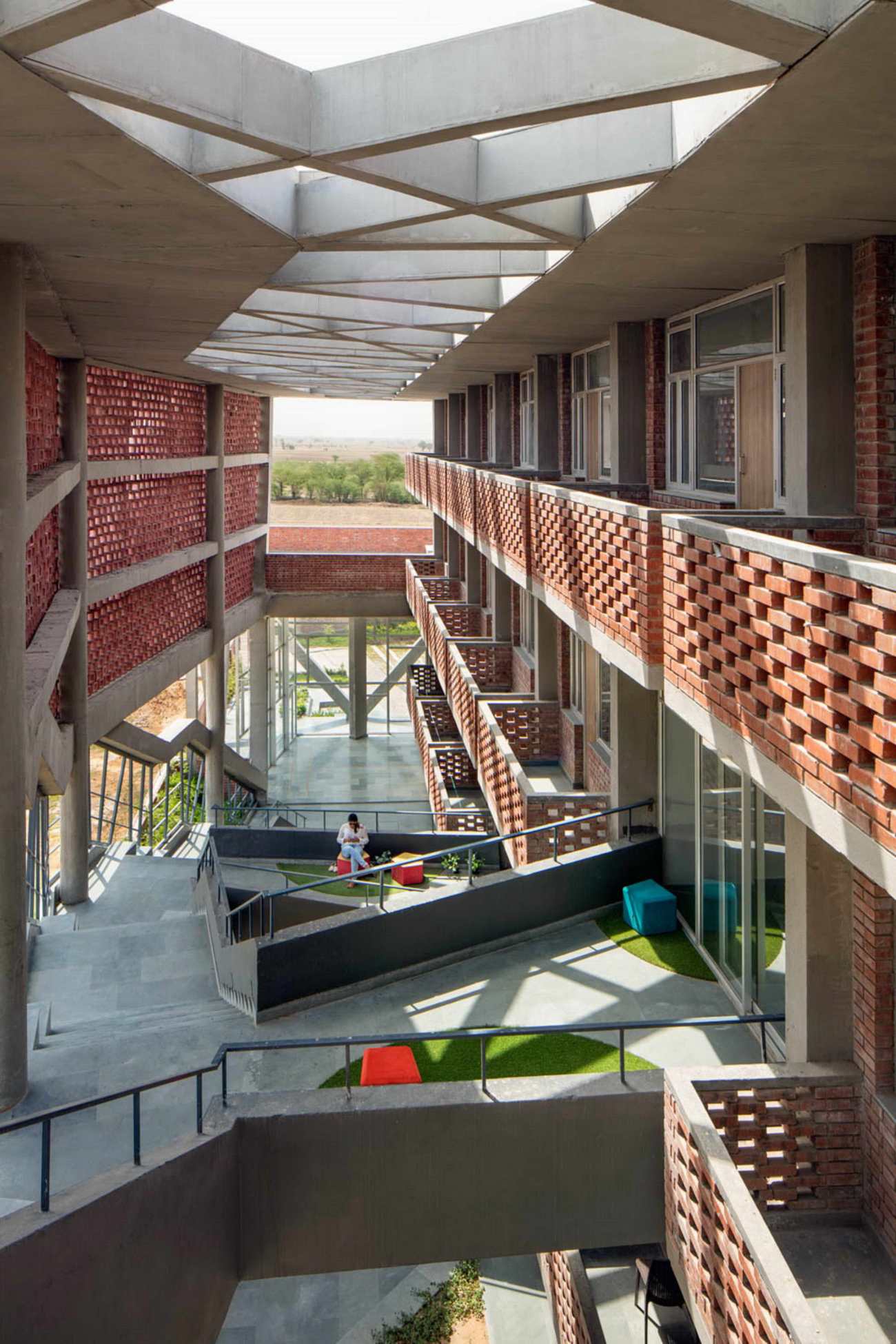 | 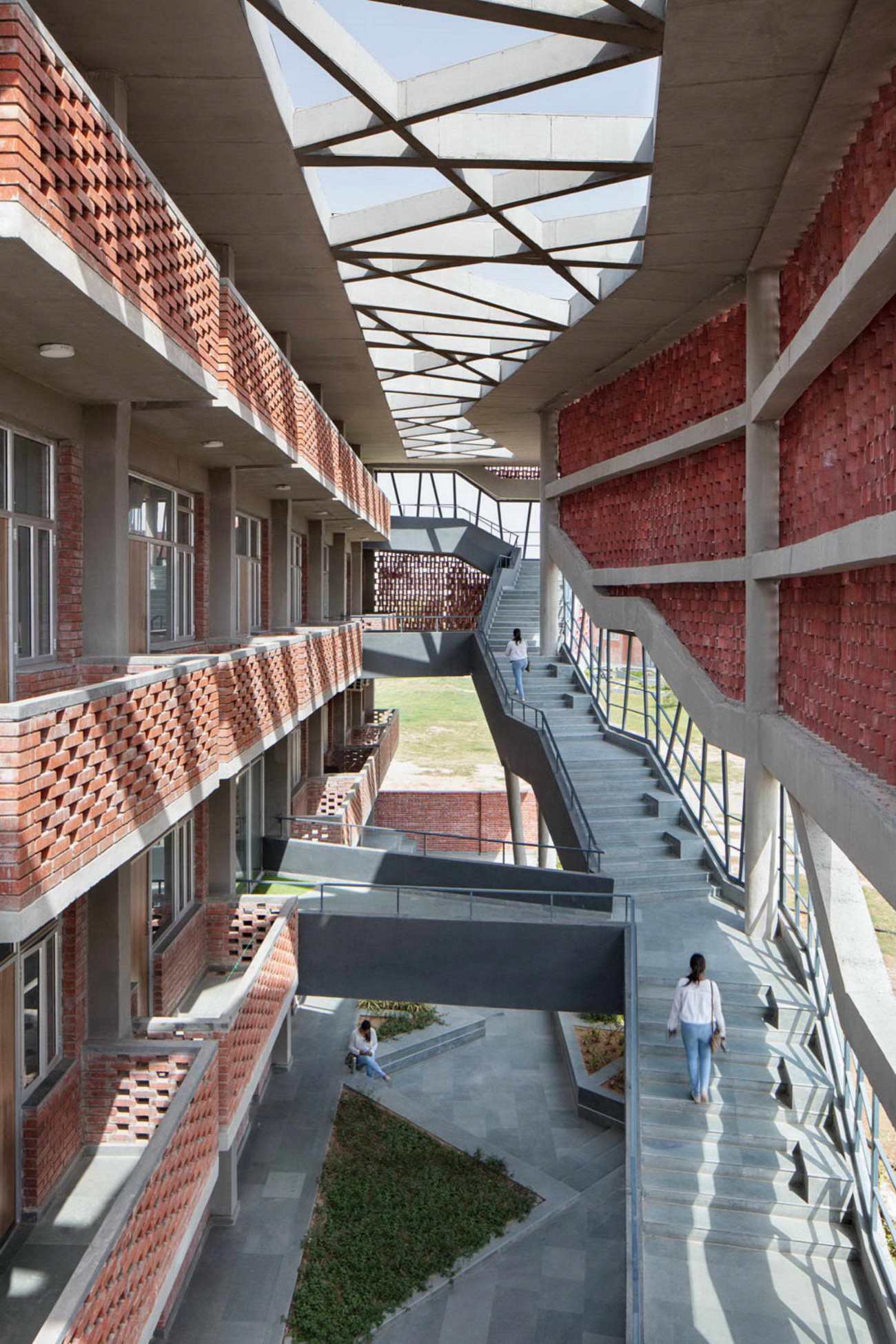 |
材料和建筑细节
建筑物的混凝土和砖块的物质化将不同的楼层结合在一起。柱子是圆形的,以加强视觉外观和物理性。此外,没有采用单一的柱子,而是将庞大的体量分解成三根柱子,形成一个类似三脚架的配置,以提供更好的结构稳定性作为垂直支撑。屋顶上的凉棚是用水泥板和钢梁设计的,以实现轻质结构和最佳设计质量。
Materiality and Architectural Details
The building’s materialization in concrete and brickwork binds the different floors together. The columns are round in shape to enhance visual appearance as well as physicality. Moreover, instead of employing singular columns, the sheer mass is broken down into three columns in a tripod-like configuration to provide better structural stability as a vertical support. The pergola on the roof is designed using cement board and steel beams to achieve lightweight construction and optimum design quality.
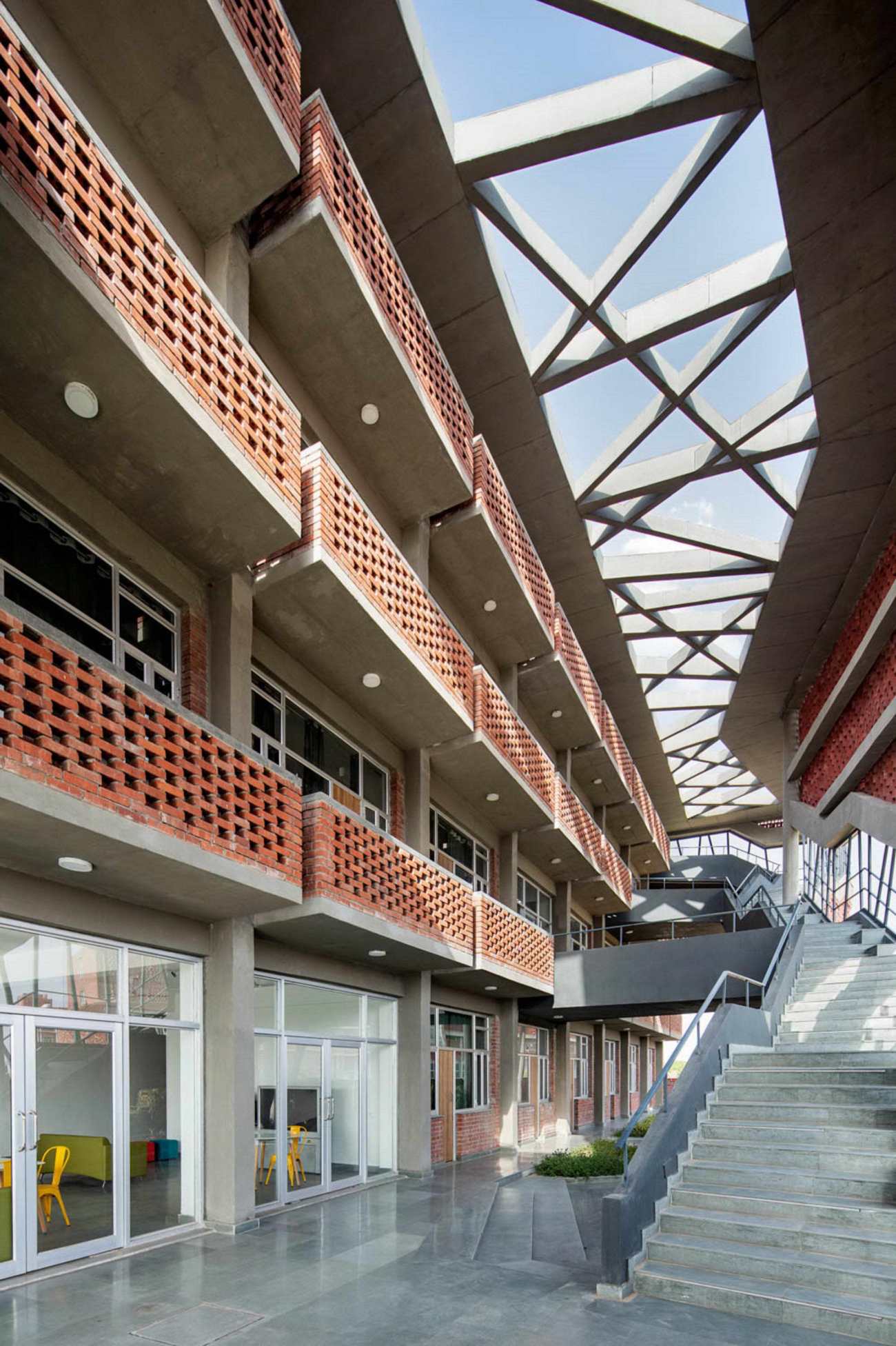 | 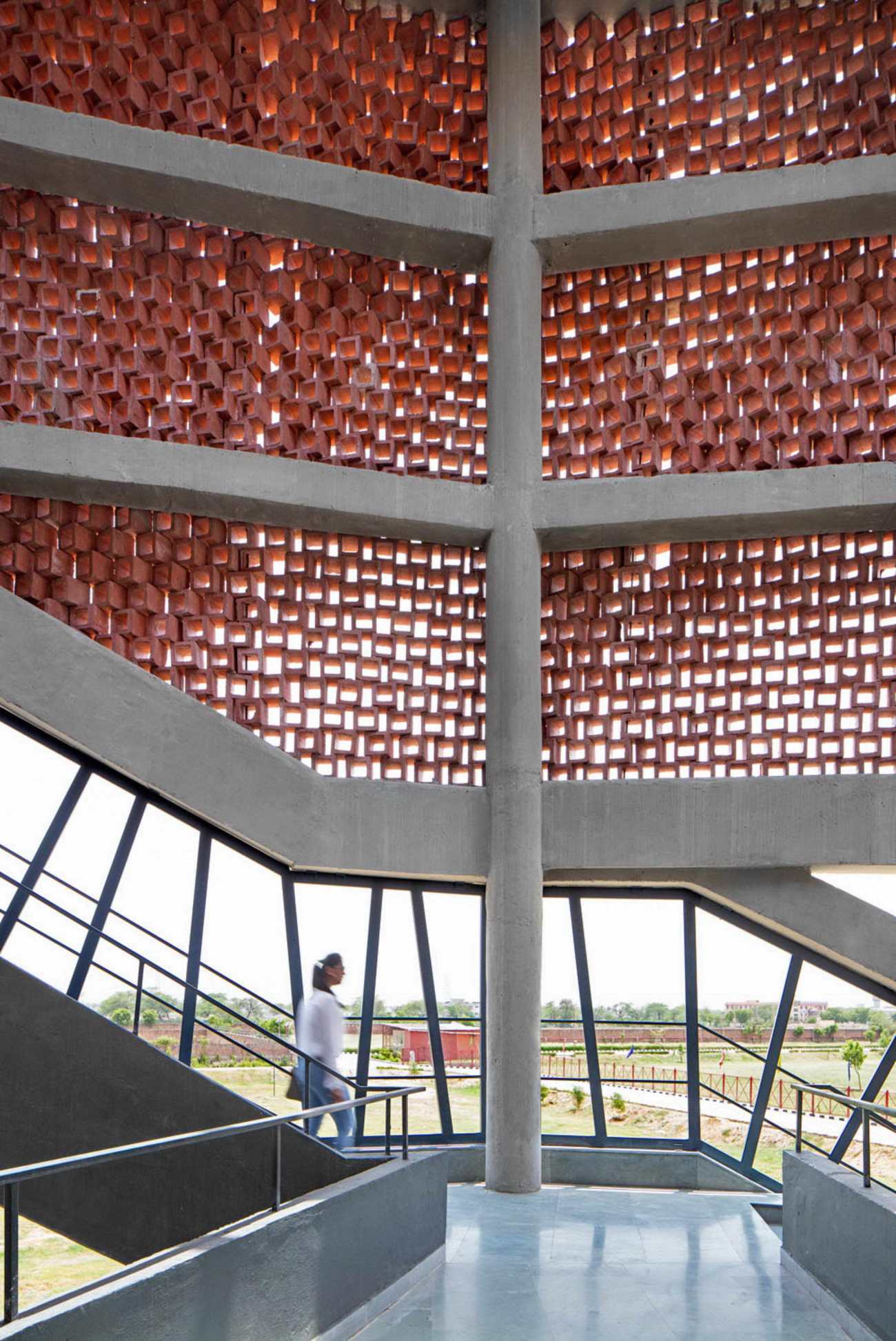 |
景观策略和水资源管理
景观设计通过将绿色植物带入室内来丰富空间,不仅起到审美作用,而且还起到功能作用。科学证明,亲近自然会对心理和生理健康产生有利的影响,并创造一个有利于互动的环境,这也是我们景观策略的指导。花槽的边缘细节被设计成座椅,使学生能够与大自然坐在一起。阴凉的院子里有多种多样的植物品种,它们需要较少的阳光照射。周边区域以竹子为特色,形成一个屏幕。在建筑外面,地面完全暴露在阳光下,由于香樟树有很大的树冠,所以种植了香樟树来创造遮阳的座位空间。户外景观球场的表面是可穿透的,有利于地下水的渗透。洗手间的水等废水被输送到污水处理厂,并被重新用于园艺用途。
Landscape Strategies and Water Management
The landscape design enriches the space by bringing the greenery inside to serve not only aesthetic but also functional purposes. Being closer to nature is scientifically proven to have a favourable impact on psychological and physiological well-being as well as create a conducive environment for interaction and this directed our landscape strategy. The edge details of the planters are designed as seaters, allowing students to sit with nature. The shaded courtyard hosts a diverse variety of plant species which require a lesser exposure to sun. The peripheral areas feature bamboo that creates a screen. Outside the building, where the ground is completely exposed to the sun, champa trees have been planted due to their large canopies to create shaded seating spaces. The surface of the outdoor landscaped court is penetrable, facilitating ground water penetration. The wastewater such as water from the washrooms is conveyed to the sewage treatment plant and is reused for horticulture purposes.
可持续性和能源效率
女生宿舍楼通过其节能设计成为可持续性的典范。双层外墙作为热质量,将主要外墙的入射直接和扩散辐射减少了70%,从而最大限度地减少了墙体后面可居住空间的热增益。这进一步减少了35%的机械冷却负荷,与ECBC(节能建筑规范)公共建筑的基本情况相比,有了明显的增加。
Sustainability and Energy Efficiency
The Girls’ Hostel building is an exemplar of sustainability through its energy efficient design. The double-skin facade acts as thermal mass, reducing the incident direct and diffused radiations by 70% on the principal façade, thus, minimizing heat gain within the habitable spaces behind the block wall. This further reduced the mechanical cooling loads by 35%, a marked increment from the ECBC (Energy Conservation Building Code) base case of public buildings.
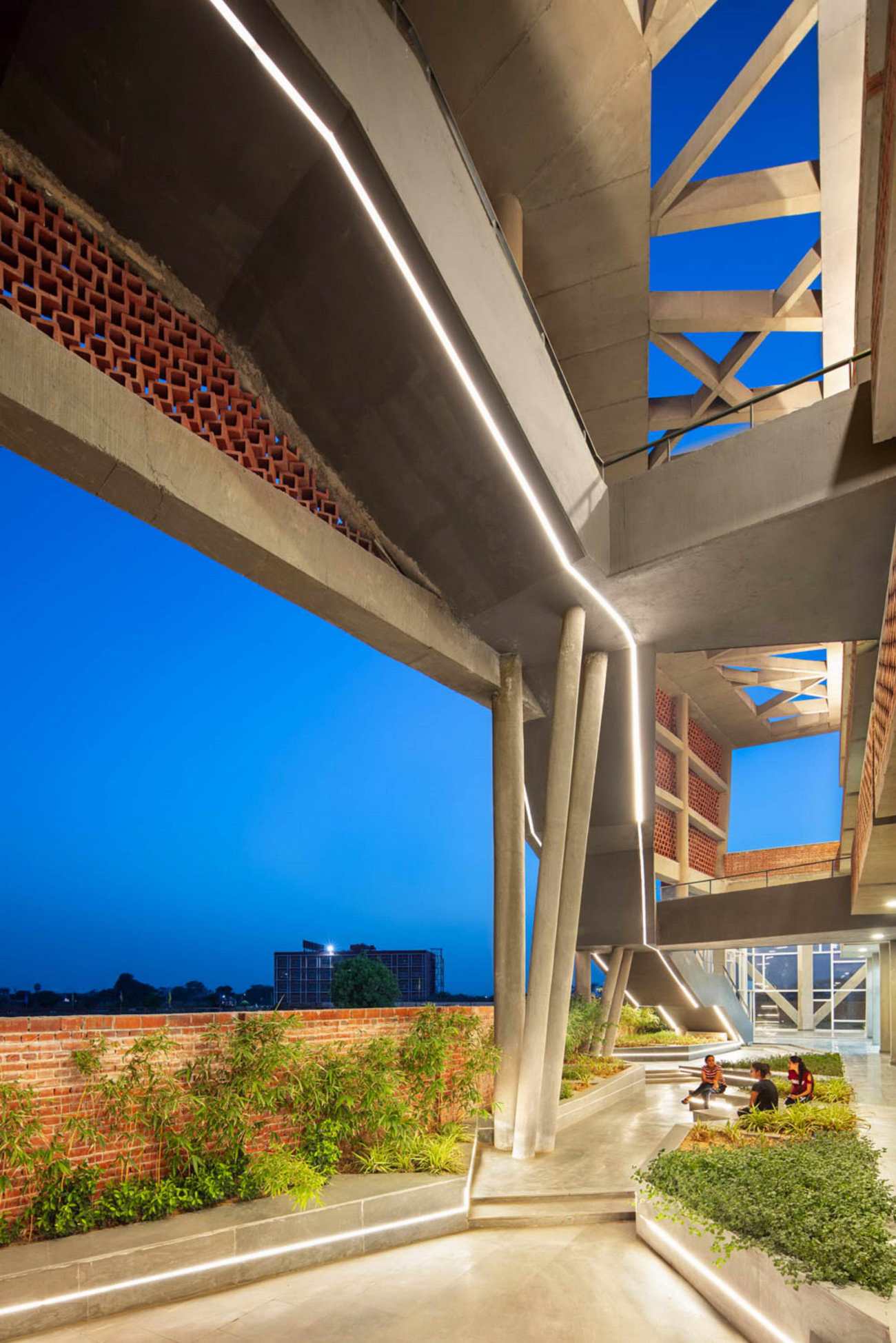 | 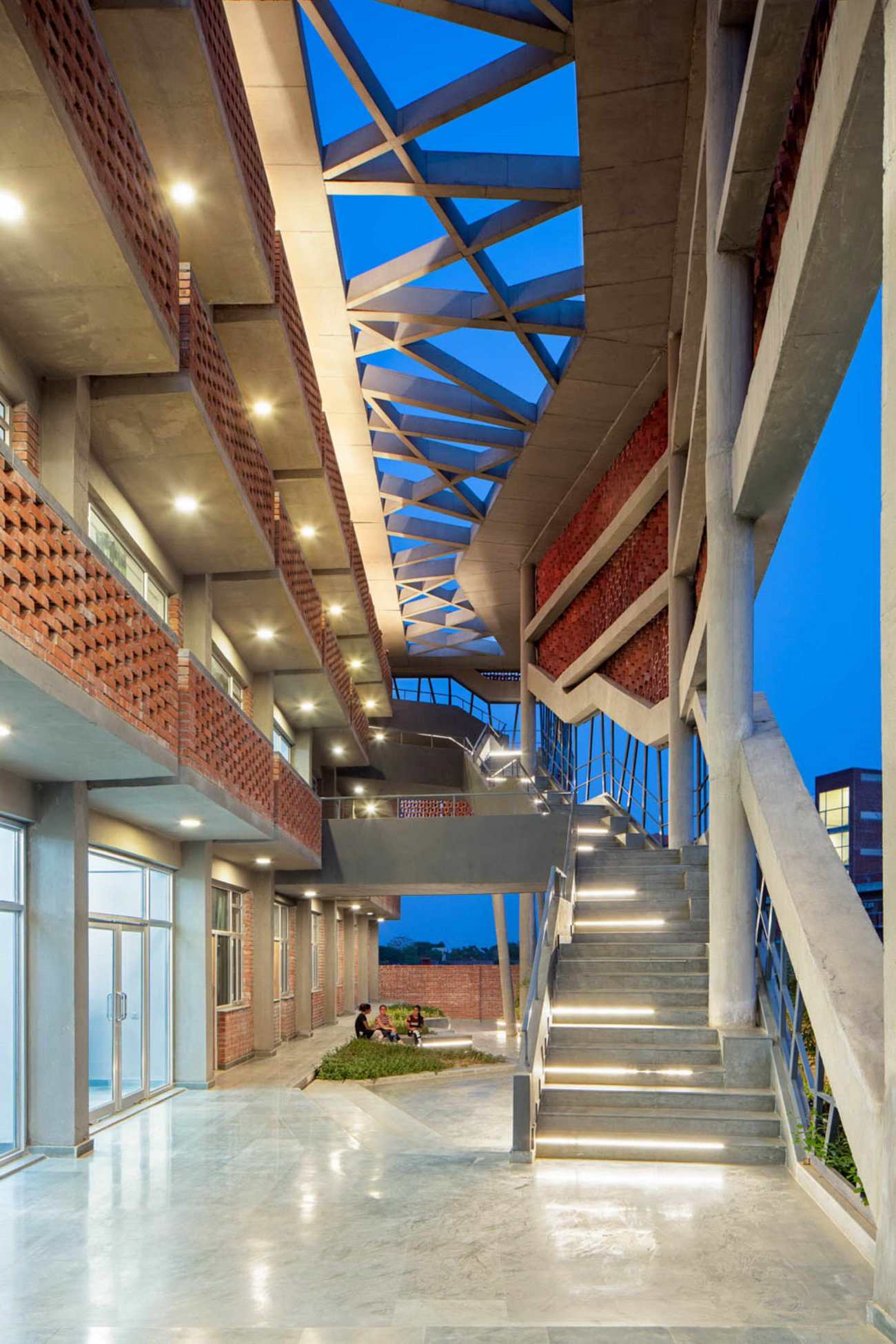 |
Project: St. Andrews Institute of Technology and Management: Girls’ Hostel Block
Built Up Area: 25,000 sq.ft.
Location: Gurugram, Haryana, India
Status: Completed in 2020
Client: St. Andrews Group
ACP / Glass / Concrete: ULTRATECH
Sanitary ware / Fittings
Flooring: KOTA
Air Conditioning: SAMSUNG
Paint: ASIAN PAINTS
Elevator
CONTRACTORS
Electrical: Civil- LS ASSOSIATES
Landscape: HVAC
Plumbing: PMC
Façade: LS ASSOSIATES
Photo Credit: Noughts and Crosses
更新日期:2021-06-17 15:27:49
非常感谢 Zero Energy Design Lab 带来的精彩项目, 查阅更多Appreciations towards Zero Energy Design Lab for sharing wonderful work on hhlloo. Click to see more works!
